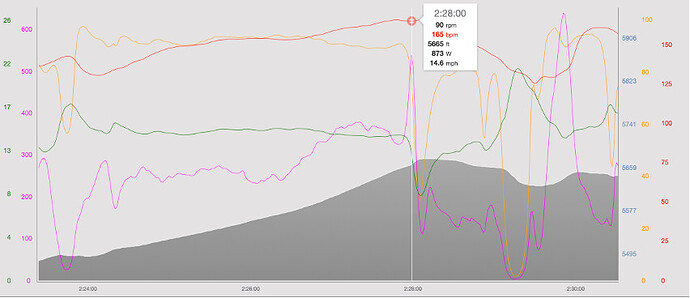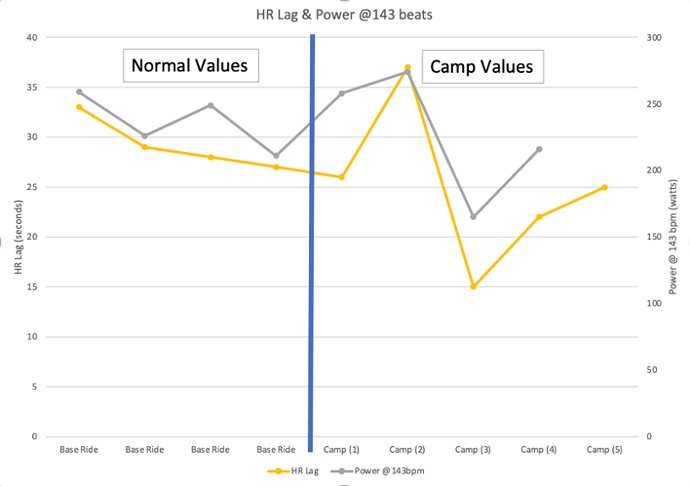What a week that was! I’m not going to pretend that I did epic rides day after day in this training camp because that just wasn’t the case. Even calling it a training camp is probably a stretch for this time-crunched athlete. Instead, this was more of a large “overload week,” but still came with all the good effects from a training camp, just packaged up in something more manageable. Let’s start with the overview:
Background training leading up to the overload week –
-
- average of 7 hours per week over past 12 weeks
-
- Average weekly mileage was just shy of 100 miles per week over the same time period
-
- Most weeks were primarily indoor riding with a few commutes, usually 1 HIIT workout per week, and the occasional Zwift race here and there. My overall training distribution primarily reflected a “base” approach
Camp goals –
-
- Bump my training load above and beyond what I accomplished in recent months (weekly load averaged 340 TSS before camp)
-
- Accomplish as much riding as possible without negatively impacting family commitments
-
- Come out of the overload week feeling fatigued and ready for some rest
Camp outcome –
-
- Training volume was 14 hours for the week, doubling my average
-
- Training load was 670 TSS, nearly doubling my peak load in the past 12 weeks
-
- The family was very supportive as the training didn’t negatively impact our activities
-
- I experienced indicators that suggested overload occurred
Day 1
Day 1 was the first training ride with my junior MTB team, so we were doing threshold intervals. This was a great way to start the overload week and put in some miles on the dirt versus past rides that mostly took place on the road or trainer. ~30 miles that day.
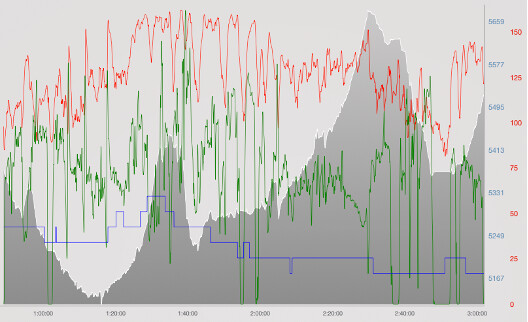
Day 2
Day 2 was a commute day, to and from work. Both rides were on the singlespeed MTB since I’m also preparing for an early May 50k MTB race on the SS. So, while HR was relatively low for the commutes, torque production was the focus today. The legs were starting to feel that combination of the backpack + the training session from day 1.
Day 3
Day 3 started on the bikes with Trevor and Chris where we did some video production while riding up Sunshine Canyon, a beautiful climb that leaves from downtown Boulder. This is where my lack of specific training to date really showed. We accumulated about 4500’ of elevation gain that morning and the legs were feeling it. The body was off, and physiologically this was the low performance day of the week. The power/HR relationship reflected this as shown in the chart below. You can see a good bit of decoupling occurring from the first half to the second half of the climb. Fatigue was really increasing, and this ride pushed me. Because the goal of this week was to achieve an overload, this was ok. It was an appropriate time to push through while fatigued. I focused on fueling and hydration to keep energy levels as high as possible, so although the legs didn’t have the power today, I was still delivering nutrition to the body to accomplish the ride and continue preparing for upcoming rides.
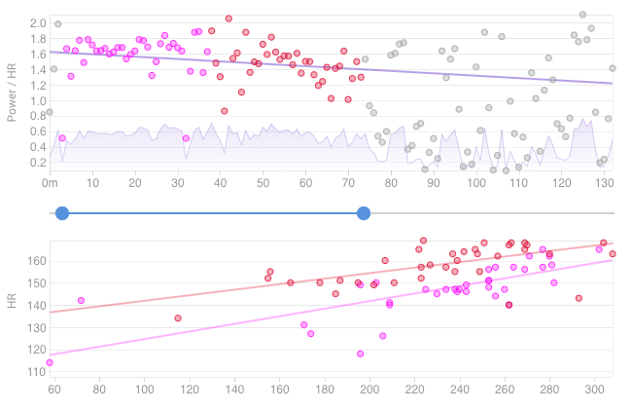
Lastly, this day wasn’t over once we completed this ride in the foothills – in the afternoon I had the second day of team training with my junior MTB squad where we hit some more threshold efforts again and achieved ~30 miles on the dirt at a solid tempo. So, this was a little over 5 hours on the day. The legs were pretty cooked that evening.
Day 4
This was a good one. The body put the painkillers to work after day 3 and the legs felt pretty spectacular to start. So I decided to take the singlespeed out to play in the dirt for as long as possible. Ended up with 32 miles. Aerobically, things felt really good. So good, in fact, that near the end of the ride I thought I had enough in me to give a pretty sizeable VO2 max effort and go for some Strava segments. This is where the overload week was showing its effects. As you can see below, peak power was only 873 watts, and even 2-minute power was only 330w. Fresh, I’ll see 2-minute power over 500 watts and peak power north of 1300 watts, so this was an indicator that the top end was definitely compromised and that the camp fatigue was very much present, as much as I might not have felt it thanks to the painkiller effect.
You’ll also see that HR, after 4 minutes of going hard, peaked at 166-167 beats. I was capped there. Normally I’ll reach the upper 170’s after an effort like that in a fresh state, but with the last couple days already in the legs, this was the indicator I needed that 1) I was going to pay for this the next day, and 2) the overload goal has been accomplished.
Day 5
The final day I woke up with the motivation to ride, but every time I thought about this great, epic route into the mountains, the legs just said, “nope, sorry guy, not today!” So, this turned into a pastry ride. I decided to listen to the body and do a very easy spin around town, at a nice endurance effort, and finish at a great local bakery for some pastry. You can see how light this ride was in the chart below (top), compared to previous rides that week (bottom):
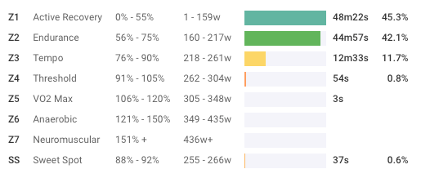

Take-home points:
Turning back toward the time-crunched focus and looking to avoid negatively impacting family time, this overload week out perfectly. While I would have loved to do longer rides and get 4-6 hours in over 3-4 days to end up with a similar training load to better approximate the durations that would be required for my N1 Challenge at the Breck Epic, that just was not a reality at this time. So instead, this was a scenario where the need to maximize overload had to be spread out over 5 days with most days being on the shorter side. To account for the training load, the intensity had to be increased across these relatively shorter days. Contrast this to @trevor’s camp and you’ll see that we both basically doubled our training time. But for a time-crunched athlete training ~7-8 hours per week, I’m not going to do a 30 hour training week. It has to be specific to your individual needs.
The training load was big, doubling my peak load over the past 12 weeks. It’s all relative too, so if you have a lot of commitments and are unable to dedicate large weekly volumes, there are ways to build your season to gradually accommodate those larger loads, strategically. One key thing to avoid is crushing yourself too early in the season. Build flexibility into the plan to allow for the type of rides you choose, along with the intensity of the rides, to adjust as necessary to meet your needs. For example, I was able to come out of this overload week feeling fatigued, looking forward to a recovery week, and not feeling like my soul was sucked out of my body. If that soul-sucking were to happen, there would be psychological pitfalls where I wouldn’t look forward to being on the bike, or I might notice a drastic change in mood. Both of these outcomes would have the potential to extend the recovery period or just make it harder to get back to normal training.
Some other metrics I have been paying attention to along the way include heart rate lag and power at a set heart rate.
HR lag shows how long it takes the HR to respond following an increase in power output. Since HR doesn’t respond immediately to increases in power, there will be a lag time. Larger changes can highlight differences in our performance and our sympathetic/parasympathetic balance. On day 3 of the overload week, HR lag went from its usual range of 30-45 seconds when fresh to 15 seconds on this difficult camp day. I was under more and more training stress by this time. This 15s response time told me that there was definitely a heightened response on fatigued legs and that things were moving “downhill” (so I knew I didn’t have many more camp days in my legs at this point)
Using a specific heart rate (143 beats) as an intensity to compare power response over time, my usual response is between 220-270 watts when I’m relatively fresh. However, on day 3 of the camp, this power output was 165 watts. This was a standout because the power was so much lower. This is a great indicator that something is going on and the body is fatigued.
Check out the chart below. This is a simple comparison of my normal values on some different base rides compared to the 5 days of camp. You will notice there is no data on day 5. This was the easy day where my HR didn’t even reach 143 beats, so there was no power to align with that HR value. However, we can see on day 4 that the power was starting to creep back up.
Looking at all the data that we are able to collect from blocks like this, I am still a huge proponent of using these opportunities to tie the data to your perception of effort. So, when you are planning your training block or a training camp, plan out your expectations and goals for the camp so you can go into it with good direction. Allow for some flexibility to suit your needs, especially if you’re time crunched. Finally, don’t follow an arbitrary camp volume (e.g., 6 hours per week normal volume doesn’t mean you do a 25 hour camp). Push your limits while individualizing the days to your response. Tie that into whatever data you collect and go through a similar process to download the information, assess what you’ve accomplished, and make plans for the next one.
Coach Ryan





